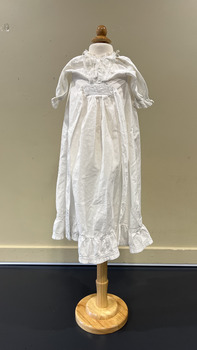Historical information
In the early 19th century, infant gowns were modelled on dresses worn by adult women. Gowns were typically made of fine white linen or cotton, and often trimmed with tucks, lace, whitework embroidery, and other handwork. The Kew Historical Society's collection includes over twenty-five gowns dating from the 19th and 20th centuries. This gown was worn by one or more of the Weir children.
Significance
This is one of ten items of clothing, worn by infants in the Weir family of Broken Hill between 1899 and 1910. They are part of the larger Weir Family collection of clothing, documents and photographs gifted to the Kew Historical Society by their descendants. Due to their known provenence, the gowns are historically and aesthetically significant in that they can be accurately dated to an 11-year-period, allowing other comparable items of infant's and children's clothing to be dated to an earlier, silmilar or later period. They also exemplify the styles and decorative techniques used for christening gowns, infant's and children's clothing of the period.
Physical description
Long, white cotton infant's gown. This high-necked gown with elbow length sleeves is less ornate than the three christening gowns in the Weir Family Collection, indicating that it was used for daily wear by one of the Weir children in the first six months of their life. The looser ruching at the waist would indicate a later date in the period 1899-1910. The gown includes a tie at the waist and a ruffled band forming the hem.
Inscriptions & markings
Nil

